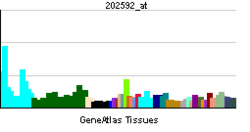BLOC1S1
| BLOC1S1 | ||||||
|---|---|---|---|---|---|---|
| Identifiers | ||||||
| Aliases | BLOC1S1, BLOS1, GCN5L1, MICoA, RT14, BORCS1, biogenesis of lysosomal organelles complex 1 subunit 1 | |||||
| External IDs | MGI: 1195276 HomoloGene: 1140 GeneCards: BLOC1S1 | |||||
| RNA expression pattern | ||||||
 | ||||||
| More reference expression data | ||||||
| Orthologs | ||||||
| Species | Human | Mouse | ||||
| Entrez | ||||||
| Ensembl | ||||||
| UniProt | ||||||
| RefSeq (mRNA) | ||||||
| RefSeq (protein) | ||||||
| Location (UCSC) | Chr 12: 55.72 – 55.72 Mb | Chr 10: 128.92 – 128.92 Mb | ||||
| PubMed search | [1] | [2] | ||||
| Wikidata | ||||||
| View/Edit Human | View/Edit Mouse |
Biogenesis of lysosome-related organelles complex 1 subunit 1 is a protein that in humans is encoded by the BLOC1S1 gene.[3][4][5]
BLOC1S1 is a component of the ubiquitously expressed BLOC1 multisubunit protein complex. BLOC1 is required for normal biogenesis of specialized organelles of the endosomal-lysosomal system, such as melanosomes and platelet dense granules (Starcevic and Dell'Angelica, 2004).[supplied by OMIM][5]
Interactions
BLOC1S1 has been shown to interact with BLOC1S2,[4] SNAPAP[4] and PLDN.[4]
References
- ↑ "Human PubMed Reference:".
- ↑ "Mouse PubMed Reference:".
- ↑ Inoue M, Isomura M, Ikegawa S, Fujiwara T, Shin S, Moriya H, Nakamura Y (Jul 1996). "Isolation and characterization of a human cDNA clone (GCN5L1) homologous to GCN5, a yeast transcription activator". Cytogenet Cell Genet. 73 (1-2): 134–6. doi:10.1159/000134324. PMID 8646881.
- 1 2 3 4 Starcevic M, Dell'Angelica EC (Jun 2004). "Identification of snapin and three novel proteins (BLOS1, BLOS2, and BLOS3/reduced pigmentation) as subunits of biogenesis of lysosome-related organelles complex-1 (BLOC-1)". J Biol Chem. 279 (27): 28393–401. doi:10.1074/jbc.M402513200. PMID 15102850.
- 1 2 "Entrez Gene: BLOC1S1 biogenesis of lysosome-related organelles complex-1, subunit 1".
Further reading
- Watanabe TK, Fujiwara T, Shinomiya H, et al. (1997). "Molecular cloning of a novel human cDNA, RT14, containing a putative ORF highly conserved between human, fruit fly, and nematode.". DNA Res. 2 (5): 235–7. doi:10.1093/dnares/2.5.235. PMID 8770567.
- Ogryzko VV, Kotani T, Zhang X, et al. (1998). "Histone-like TAFs within the PCAF histone acetylase complex.". Cell. 94 (1): 35–44. doi:10.1016/S0092-8674(00)81219-2. PMID 9674425.
- McMahon SB, Wood MA, Cole MD (2000). "The essential cofactor TRRAP recruits the histone acetyltransferase hGCN5 to c-Myc.". Mol. Cell. Biol. 20 (2): 556–62. doi:10.1128/MCB.20.2.556-562.2000. PMC 85131
 . PMID 10611234.
. PMID 10611234. - Kurooka H, Honjo T (2000). "Functional interaction between the mouse notch1 intracellular region and histone acetyltransferases PCAF and GCN5.". J. Biol. Chem. 275 (22): 17211–20. doi:10.1074/jbc.M000909200. PMID 10747963.
- Strausberg RL, Feingold EA, Grouse LH, et al. (2003). "Generation and initial analysis of more than 15,000 full-length human and mouse cDNA sequences.". Proc. Natl. Acad. Sci. U.S.A. 99 (26): 16899–903. doi:10.1073/pnas.242603899. PMC 139241
 . PMID 12477932.
. PMID 12477932. - Mishra SK, Mazumdar A, Vadlamudi RK, et al. (2003). "MICoA, a novel metastasis-associated protein 1 (MTA1) interacting protein coactivator, regulates estrogen receptor-alpha transactivation functions.". J. Biol. Chem. 278 (21): 19209–19. doi:10.1074/jbc.M301968200. PMID 12639951.
- Lehner B, Semple JI, Brown SE, et al. (2004). "Analysis of a high-throughput yeast two-hybrid system and its use to predict the function of intracellular proteins encoded within the human MHC class III region.". Genomics. 83 (1): 153–67. doi:10.1016/S0888-7543(03)00235-0. PMID 14667819.
This article is issued from Wikipedia - version of the 6/6/2016. The text is available under the Creative Commons Attribution/Share Alike but additional terms may apply for the media files.